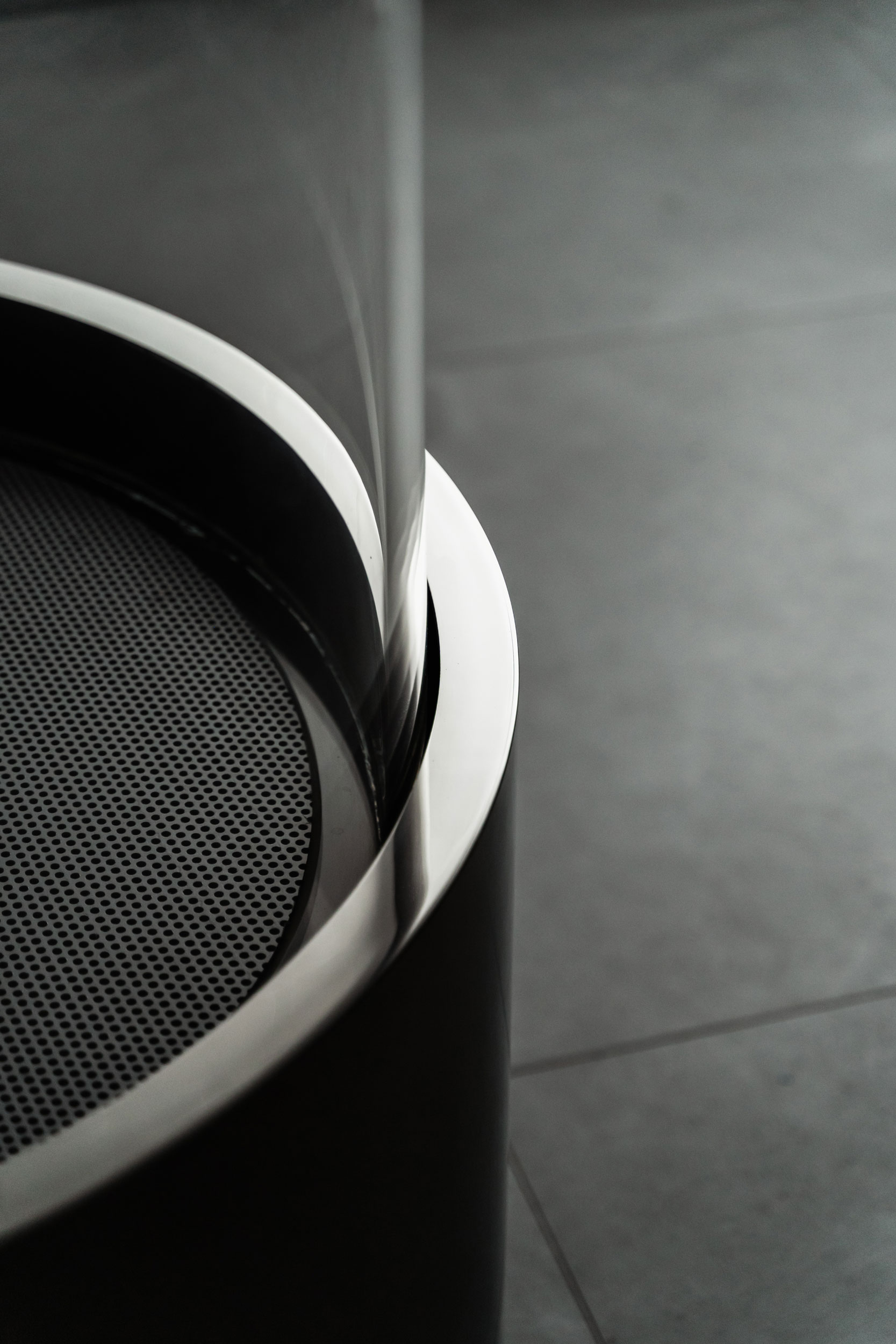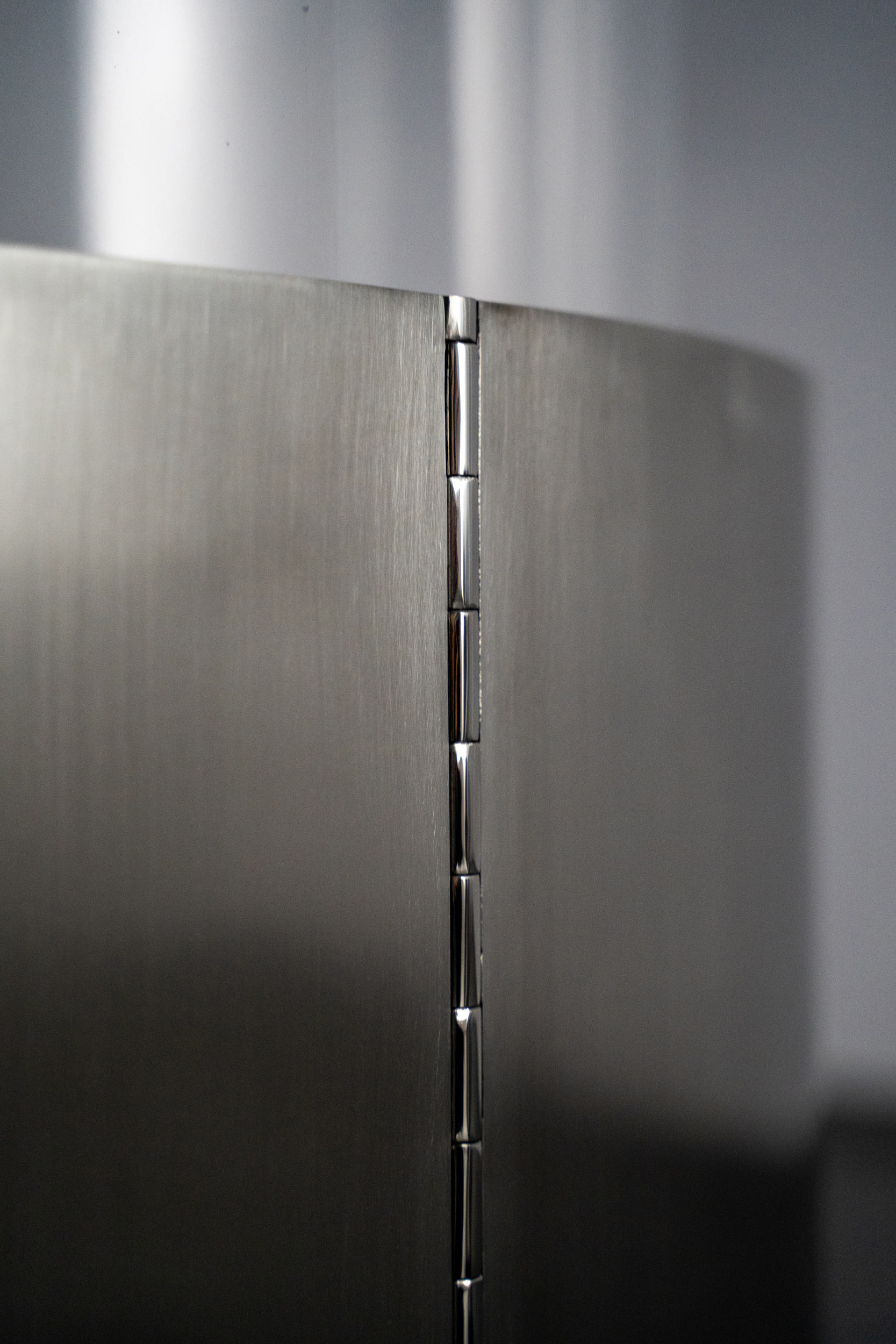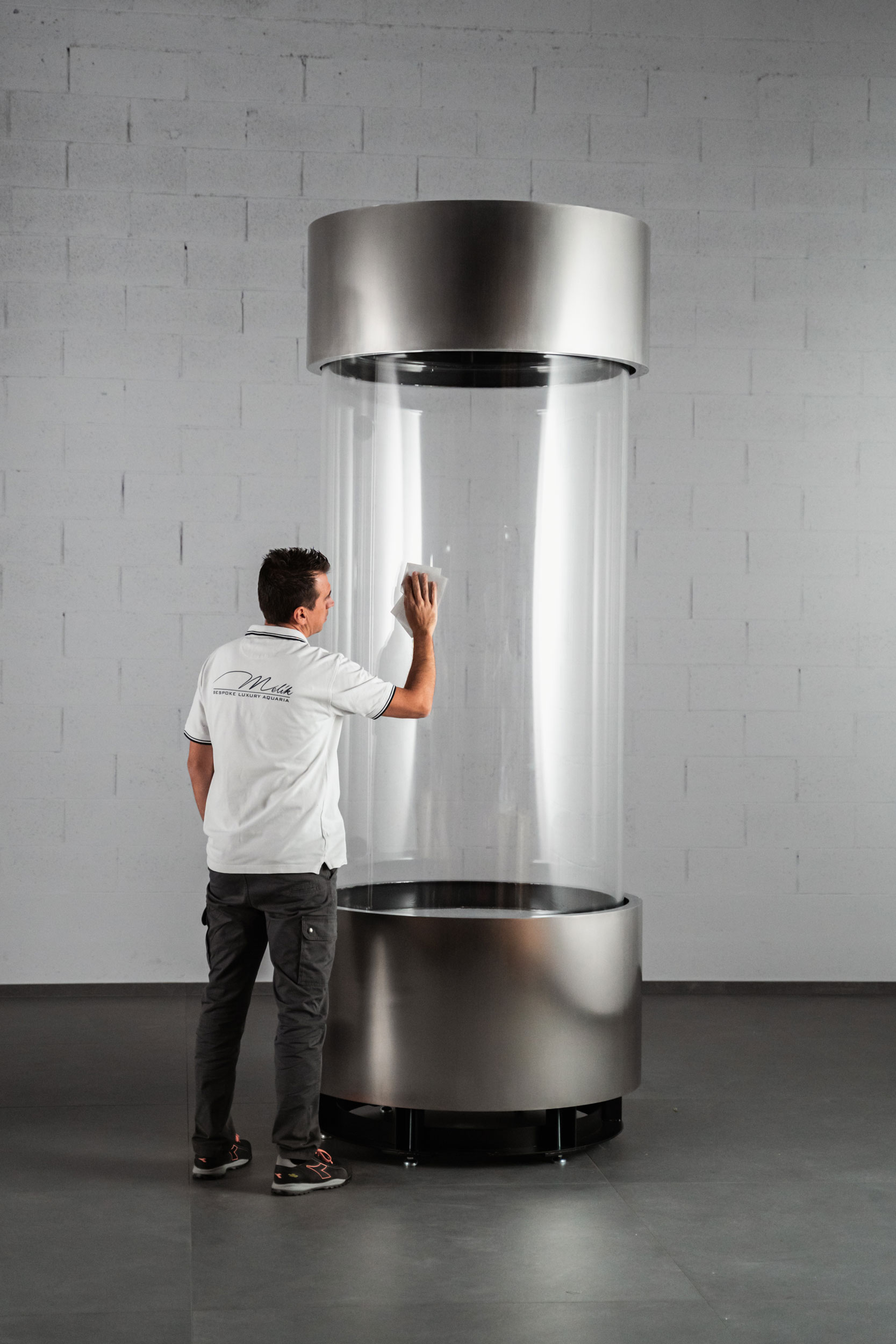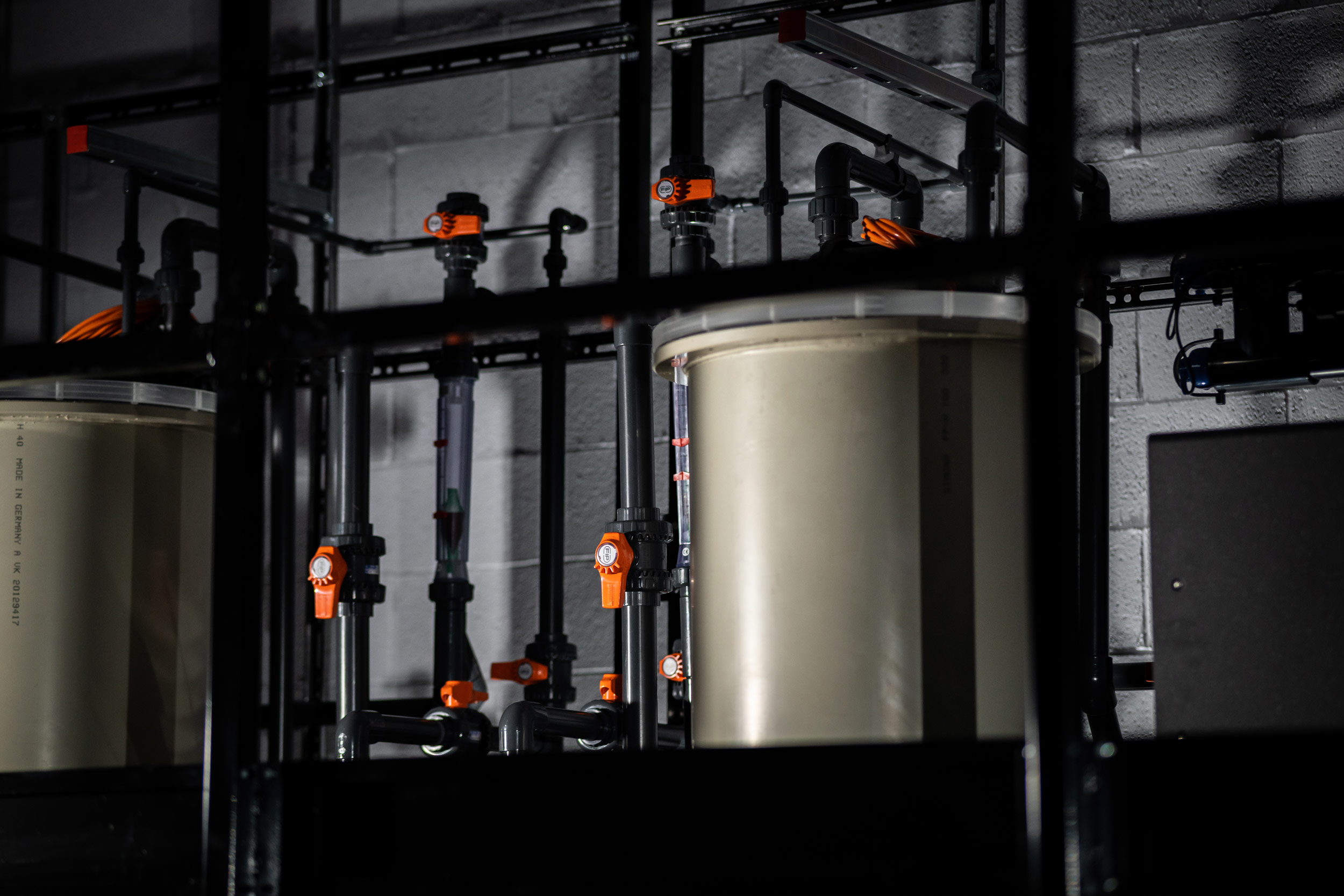Unique and evocative atmosphere
CANNES
Jellyfish aquariums
Jellyfish and their hypnotic dance
Minimalist design
Jellyfish aquariums are made with the goal of creating a stunning visual experience. The minimalist and futuristic aesthetic of these aquariums fits perfectly with the environment in which they have been placed. The combination of plexiglass and stainless steel denotes clean shapes and a clear perception of the quality materials used.
The project
Jellyfish aquarium
In the context of luxury furnishings, jellyfish aquariums represent an exclusive and fascinating choice. Imagine two circular methacrylate aquariums, 2 meters high, which enchant with their beauty and offer a unique scenographic spectacle. These living works of art, custom-crafted from high-quality materials such as 316 stainless steel, convey a sense of majesty and elegance. Each aquarium has a volume of 1600 litres, providing generous space to house a variety of fascinating jellyfish.
The jellyfish aquariums described are a true example of high-quality craftsmanship. Made to measure, they are the result of advanced craftsmanship and meticulous attention to every detail. The transparent methacrylate offers a crystal clear vision of the marine environment, while the 316 stainless steel infills give a touch of elegance and resistance. This combination of high-quality materials creates a unique work of art that stands out for its timeless beauty.
Lighting plays a vital role in accentuating the beauty of jellyfish in aquariums. The aquariums described are equipped with latest generation LED lighting, which offers a wide range of customizable colours. This feature allows you to create a breathtaking scenographic effect, in which the jellyfish reflect the light and take on iridescent shades. You can choose your favorite color to create the desired atmosphere, ranging from warm and relaxing to lively and charming.
The project required the positioning of the filter room in a technical environment located 13 meters lower than the hall where the aquariums are positioned. This arrangement allows for effective water filtration, guarantees easy access for maintenance without interfering with the living spaces of the property. Attention to functionality and efficiency ensures adequate maintenance and optimal water quality.
The circular jellyfish aquariums described offer an enchanting and unique experience. Jellyfish, with their light movements and hypnotic colours, create a fascinating spectacle that captures the imagination.
4500
300
850
Wellbeing benefits
The presence of a jellyfish aquarium in a residential setting can offer a number of wellbeing benefits. Watching jellyfish in motion can have a calming effect and reduce stress. Their elegant and hypnotic dance can promote a feeling of tranquility and relaxation. Jellyfish aquariums are therefore considered true living works of art, capable of enriching the surrounding environment and creating a unique atmosphere.
technique at your service
Attention to detail and tailor-made design make this professional filter system an indispensable ally for jellyfish aquariums. Its robust structure, efficient filters and computerized control system create an optimal environment, allowing you to maintain ideal conditions for the life and health of jellyfish. It guarantees 24-hour control of water density, temperature, pH and redox potential, possibility of automatic water changes and refilling of evaporated water.
The heart of the system is made up of polypropylene filters, also customized to adapt to the specific needs of the jellyfish marine environment. These filters are designed to effectively remove impurities, maintaining optimal water parameters.
In conclusion, the professional filter system represented here is a work of engineering dedicated to the well-being of jellyfish. Combining accurate preliminary design, a functional metal carpentry structure, custom-made filters and computerized control, they offer a controlled and safe environment for these fascinating marine creatures.
Advice on breeding jellyfish
Jellyfish aquariums
Jellyfish in Nature
Discover some curiosities about these extraordinary creatures, what are their habits? What is their life cycle and their role in the marine ecosystem? They are animals with incredible survival skills and their variety of shapes and colors. Let's delve into some interesting aspects of these unique and often unknown creatures.
What genus does jellyfish belong to?
Jellyfish belong to the Cnidaria phylum, which also includes creatures such as sea anemones and corals. Within this phylum, jellyfish are part of the class called Scyphozoa. Their tentacles have different shapes and sizes and can also be equipped with stinging cells called cnidocytes. These tentacles are used to capture prey and defend themselves from predators.
How do jellyfish reproduce?
Jellyfish reproduce through a complex life cycle involving several stages. The jellyfish reproduction process usually includes the following steps:
- Sexual phase: Adult jellyfish release their eggs or sperm into the water. Fertilized eggs develop into embryos inside a special pocket called a gonad.
- Planula larva: From the fertilized eggs, planula larvae develop, which are small, ciliated, free organisms that swim in the water.
- Polyp phase: Planulae larvae attach to a solid surface and develop into polyps, which are sessile organisms that resemble small tubes or stalks. During this phase, polyps feed on small planktonic organisms present in the water.
- Pudding: Polyps produce buds through the process of budding or splitting, thus generating new young jellyfish, also called ephyrae. Ephyrae develop and grow into mature jellyfish.
- Adult jellyfish: The mature ephyrae detach from the polyp and become mature jellyfish, completing the life cycle.
This complex life cycle allows jellyfish to reproduce and proliferate in various marine habitats. Jellyfish reproduction is influenced by environmental factors such as water temperature and food availability.
What do jellyfish feed on in nature?
Jellyfish feed mainly on small planktonic organisms, such as copepods, small crustaceans, fish larvae, fish eggs and other microscopic organisms present in the water. They use their tentacles to capture prey, often equipped with stinging cells called cnidocytes, which release a poisonous substance to paralyze or kill prey.
Jellyfish can also feed on zooplankton, phytoplankton, and other small aquatic organisms found in their environment. Some jellyfish species are opportunistic and can capture a wide range of prey, while others specialize in certain types of food.
It is important to note that jellyfish do not have a complex digestive system like many other animals, but they do have a gastrovascular cavity that serves as a stomach. After catching prey, jellyfish digest them inside this cavity, absorbing nutrients through the body wall.
How long do jellyfish live?
The lifespan of jellyfish varies greatly depending on the species, the environment they live in, and other environmental factors. In general, many jellyfish have a relatively short life cycle, which can last from a few weeks to several months.
Some jellyfish species, such as Turritopsis dohrnii, also known as the “immortal jellyfish,” have the ability to undergo a process called undifferentiated cellular transformation, which allows them to return to the polyp stage after reaching adulthood. This “immortal” life cycle can continue indefinitely, allowing these jellyfish to theoretically live for a much longer time than other species.
However, most jellyfish do not possess this ability and are relatively short-lived. Jellyfish may be subject to predators, disease, environmental changes and other factors that affect their longevity. In general, it is difficult to give an exact age for jellyfish, as it varies greatly from species to species and from individual to individual.
How to breed a jellyfish in an aquarium?
Recently, the breeding of jellyfish in captivity has seen a dramatic increase due to the great demand from the food and aquarium sectors. Breeding jellyfish in the aquarium has become relatively simple even for enthusiasts as long as they choose professional filtering and a specific management method for the species included. Unlike a few years ago, today the supply of these wonderful animals reproduced and bred in captivity is relatively simple.
What shape should a jellyfish aquarium have?
Aquariums designed to house jellyfish often feature specific shapes and designs that take into account the unique needs of these marine organisms. Here are some common characteristics of jellyfish aquariums:
- Cylindrical or kreisel shape: Jellyfish aquariums often have a cylindrical or column shape, which allows the jellyfish to move freely and not come into contact with the walls of the aquarium, thus reducing the risk of damage to their delicate body structures.
- Kreisel: as an alternative to cylindrical shapes it is possible to build non-cylindrical aquariums generally called kreisel, a system with which there is a rotary movement of the water capable of making the jellyfish move continuously, avoiding them hitting the walls of the tank.
Both types of aquarium must have smooth walls free of obstacles to avoid superficial injuries to these delicate animals.
What kind of jellyfish can I put inside?
To date, there are many species that we can include in the aquarium, some simpler, others more difficult to maintain:
- Aurelia aurita: Also known as the common jellyfish or moon jellyfish, it is one of the most widespread and popular jellyfish species in home aquariums. It is characterized by a transparent body with four circle-shaped swellings and long tentacles.
- Cannonball Sp: The jellyfish Stomolophus meleagris, also called cannonball jellyfish, is an umbrella jellyfish of the order root-mouthed jellyfish. These jellyfish are quite hardy and very fast and active swimmers. They have a yellowish/milky and sometimes even bluish, dome-shaped umbrella. It is found on the western Atlantic coast, the eastern Pacific coast, the Japanese Sea, and also in some areas of the tropical Atlantic and Caribbean.
- Chrysaora spp.: This genus includes several species of jellyfish, some of which can be successfully kept in the aquarium. They are characterized by long, thin tentacles and a bell-shaped body, the Chrysaora pacifica, also known as the Japanese compass jellyfish, is found mainly in the waters around Japan (southwestern Pacific). Japanese compass jellyfish have a whitish umbrella with orange stripes and very long tentacles that can reach 3 m in length
- Cassiopea spp.: Also known as upside-down jellyfish, these jellyfish are characterized by a flat appearance and tentacles that extend upward. They are often kept in aquariums due to their unique appearance and interesting behavior.
- Lychnorhiza spp.: These jellyfish have an umbrella-like appearance and are characterized by short, stout tentacles. Some species of Lychnorhiza can be kept in the aquarium, although they may require larger spaces due to their size.
- Phyllorhiza punctata: Also known as the Australian puffball jellyfish, this species is characterized by a transparent body with brown spots and short tentacles. It is one of the most commonly kept jellyfish species in aquariums.
Do jellyfish aquariums need maintenance?
Every aquarium needs regular maintenance. Jellyfish aquariums also need to be constantly monitored like marine aquariums. We recommend cleaning the glass with a magnet every 4 days, a 10% weekly water change, cleaning the skimmer (recommended for good oxygenation of the water) and removing any food deposited on the bottom.
What do jellyfish eat in aquariums?
It is preferable to feed jellyfish with live artemia enriched with vitamins. This type of food guarantees rapid growth of jellyfish and a correct supply of nutrients. It is also possible to feed jellyfish with powdered food but it is not recommended because it tends to dirty the water much more and settle on the bottom of the aquarium.
How much does a jellyfish aquarium cost?
Today on the market there are solutions for all budgets: from €300 for small 15 liter kreisels up to €10000 for aquariums equipped with professional filtering. Our advice is to set up an aquarium always and only if equipped with correct filtering. Always remember that success in an aquarium depends almost exclusively on the type of filtering and the technical equipment installed.
How long do jellyfish live in aquariums?
If correctly fed and housed in professional aquariums, jellyfish generally live for about a year.
What temperature and density should I maintain in the aquarium?
Jellyfish generally live from 15-30 degrees depending on the species. Salinity can be maintained around 30 – 35 g/L.
Jellyfish in the Aquarium
Raising jellyfish in captivity requires a combination of attention, experience and a correct understanding of the needs of these delicate marine organisms. The shape of the aquarium is essential to ensure correct movement and nourishment of the jellyfish. Secondly, it is essential to maintain optimal water quality. This includes monitoring and maintaining water temperature, salinity level and water purity. Filter systems and regular water changes are key to ensuring a clean and safe environment for jellyfish. At the same time, it is essential to ensure an adequate diet for jellyfish. Many species of jellyfish feed on small planktonic organisms, such as copepods and artemia, which can also be raised at home and administered directly into the aquarium. It is important to provide them with high-quality food and ensure that they are fed regularly throughout the day.







